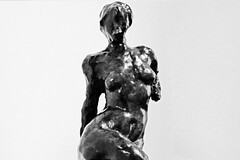Henri Matisse, Seated Nude, Arms Behind Back, 1909
IMG_1332_f
Processed 2021
And now the sculpture at the High Museum of Art that kind of blows my mind because of the way it is normally depicted as versus what my camera sees.
It's "Seated Nude, Arms Behind Back" by Henri Matisse. 1909. In bronze. The High Museum of Art describes it this way. "Matisse is best known as a painter, but he was also one of the most innovative sculptors of the early 1900s. He was able to simplify and contort the human figure into a new expressive sculptural language. Seated Nude, Arms Behind Back shows a seated female figure whose feet seem to be melting into the ground." Their image of the photo in their catalogue shows the sculpture from the left. *All* images I've seen of the sculpture show it from the left (which are actually very few images because it's not a popular sculpture) and emphasis is on the feet melting into the ground.
I have several photos of it from various angles because I was trying to figure out the head of this sculpture. The reason people photograph it from the left is because the profile, the nose, on this sculpture is a slash of material positioned very low on the head, and it's from the left that a photographer, and a viewer, can reconstruct what one is seeing into the most normal aspect of a face. One also gets a "profile" from the right side but it is more jagged, less pleasing, and so museum captures are from the left.
But if you take a photo from the front? This is, at least, what I get.
(I reversed the close-up from its normal orientation because I thought it worked well with the medium shot from the normal orientation.)
This seeming gaping (vaginal?) maw in the middle of the face. Just a trick of light? I have a difficult time ascribing this aspect to a mere trick of light that the sculptor wouldn't have noticed.
It has taken me a few years to reconcile myself with these shots being my portrait of the Matisse statue, as opposed to what other people's photographs project, as opposed to what the eye normally attempts to select, how the eye attempts to force a normal facial portrait onto the head because of the slash of material that projects from the head that is interpreted as the nose, and this is preserved in the usual depictions of the statue. I kept thinking that my shots hadn't captured it appropriately...but then I look at the articulation of light around that deep shadow in the face's interior, especially at the top of the head, how we see the decided indentation there that to me is the deciding factor of this being intentional. But when one sees this rather concealed expression--it's so stark, rather than simply replacing the woman's features with a vagina, it looks tortured. But then this is a sculpture, too, in which the woman's feet melt away. The woman's back is bent, thrusting her torso forward awkwardly, arms behind, while her legs are tightly crossed one over the other concealing the pubic/vaginal area in a way unlike other Matisse sculptures of the female form in which the legs are not crossed like this, they are quite often relaxed. When one examines how the body is placed, and the crossed legs, everything about the body somehow makes sense in combination with this "face".
The High Museum's capture, as well as the Detroit Institute of Arts, and an image from a French census of sculpture. Each of those images is taken from the left of the sculpture.
Go to this gallery's index/description
Return to Photography Galleries











